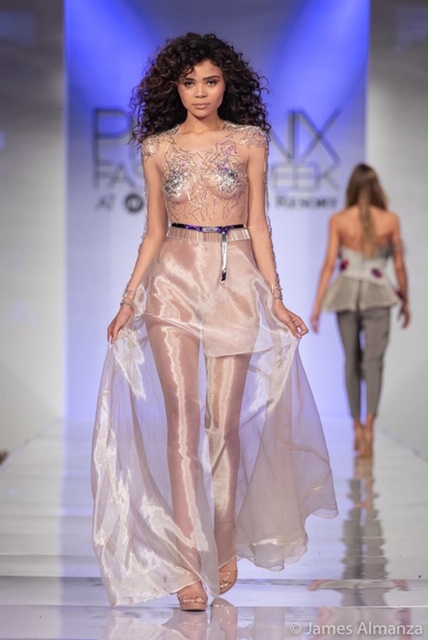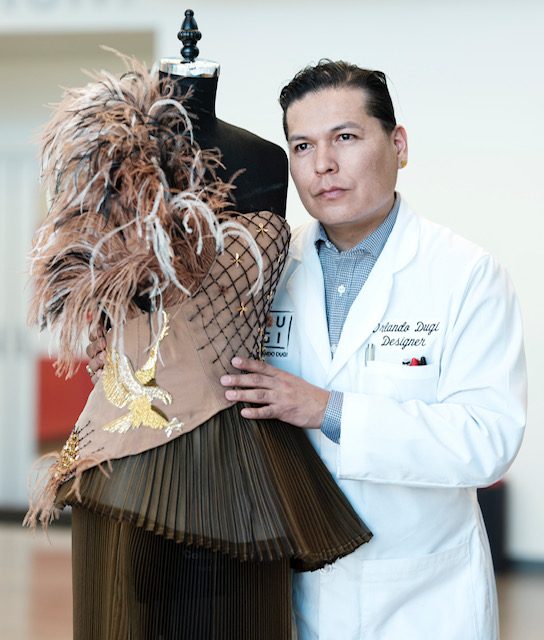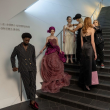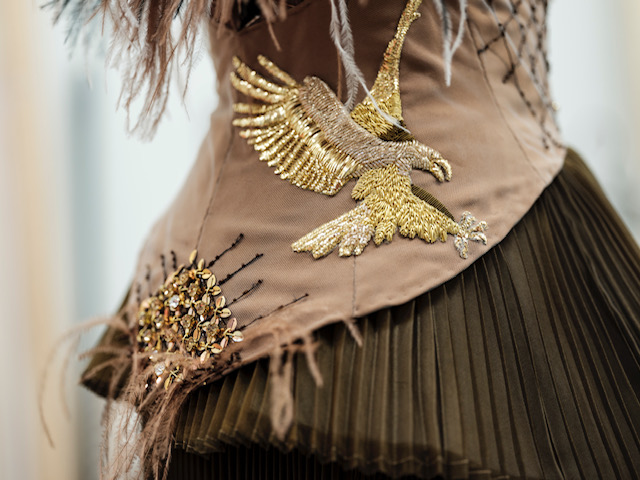Native American fashion designer, Orlando Dugi, intertwines his culture and surroundings to create exclusive and embellished pieces. Having high ambitions and a continuously growing brand, Dugi is an influence to the fashion community. “I am Diné (Navajo) from Grey Mountain, Arizona which is in North Central Arizona on the Navajo Nation. My grandmothers all made their own clothes so I was exposed to hand-sewing at an early age. However, I learned to properly sew using a sewing machine in my seventh grade home economics class,” said Dugi.
When Dugi was in his thirties he designed his first three garments. From there, he found an appreciation for the design and creative process. He currently has a high-end women’s evening wear exhibition at Colorado State University’s Avenir Museum of Design and Merchandising. The exhibit is titled “Walking in Beauty: Designs by Orlando Dugi.” His exquisite work highlights his heritage through distinct creations.

303 Magazine: Can you tell us your process for making one of your intricate pieces?
Orlando Dugi: It’s a long and slow process. First, I sketch and illustrate a design, then drape it. I then make patterns if needed — beading and embroidery designs as well. When the patterns and dyeing are done we begin any embroideries. Not all designs need embellishing and/or dyeing. Once the embroidery is done the construction begins. Most of the sewing is done by hand. The exception, however, is for long stitches. Moreover, even on some hems, it is finished by hand.
303: How do your traditions and culture tie into your fashion designs and inspiration?
OD: My designs are inspired by my culture through stories I learned as a child — as well as elaborate traditional ceremonies. A lot of my designs are inspired by all that is around me —especially nature.
303: What is the story behind your intricate beadwork technique?
OD: I first learned to bead in several ways from my paternal grandmother, Lorraine, and my father. However, most of that type of beading isn’t conducive for beading on silk. Moreover, I learned to do tambour beading and embroidery. I always knew I wanted to embellish my garments because that’s what I wanted to showcase on my first garment. With tambour beading, the fabric is stretched taut on a wooden frame.

303: Can you tell us about your exhibition of high-end evening wear at CSU’s Avenir Museum? How would you describe the collection?
OD: The work displayed at the Avenir begins with the first dress I made. It also includes a few looks from each capsule collection I’ve designed since that first dress. Altogether, it echoes the rich and elaborate cultural background of my Diné heritage — without taking sacred iconography out of their place.
303: What are you most excited about for your first solo exhibition?
OD: I’m excited to share where I come from and how I translate that into my work.
303: In three words, how would you describe your personal style?
OD: In three words it would be conservative, elaborate and simple. Sometimes, I like to wear a suit, sometimes slacks and a cardigan, sometimes I like jeans. It doesn’t always change because I wear my clothes for years until they wear out. I don’t like to think too much on what I’m going to wear.
303: What can we expect from you and your line in the near future?
OD: I’m working on designing more daywear and limited production ready-to-wear. This would still include a lot of hand finishing while continuing the special occasion garments. I’m also thinking of getting back into making accessories. I’ll continue to build my brand. It’s a very slow process, but I’m okay with that.

Dugi will speak about his latest work on Thursday, November 7 during a free public lecture at CSU. His visit to CSU is part of the university’s celebration of Native American Heritage Month. For more information about the exhibition, visit the Avenir Museum website.





